When the load is exceeded in a closed power grid, current leakage sometimes occurs. Various conductive objects become the load - the human body, batteries, bathtub, electrical appliances. An excessively high leakage current is life-threatening and has risks of damage to household appliances. For this reason, it is worth figuring out how to detect and protect yourself from the phenomenon.
- What is leakage current
- Leakage current direction
- Causes of current leakage
- From an electrical appliance in an apartment or house
- In hidden wiring in a house or apartment
- What is the danger of a leak
- Characteristic signs
- How to check and find the leakage current with your own hands
- Indicator screwdriver
- Working with a multimeter
- Continuity with a megohmmeter
- How to determine if an electrical appliance is damaged
- Finding problems in the wiring
- Means of protection
What is leakage current
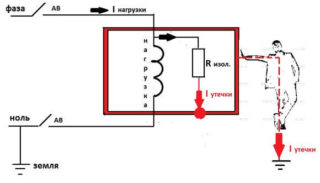
In GOST 61140-2012 and 30331.1-2013 the definition of the concept is given. Leakage current is the flow of electric current into the ground, to open, conductive, foreign objects or protective conductors under normal operating conditions.
The current is directed from phase to earth along a non-intended route:
- the housing of household equipment - washing machines or dishwashers, boilers, electric stoves;
- metal pipes of the water or gas mains;
- wet plaster layer of an apartment or house;
- other conductive paths.
The phenomenon occurs in conditions of damage to the insulation during aging, overloading of household equipment or mechanical damage to the wiring.
Leakage current direction
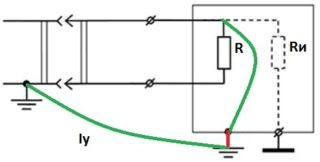
The direction of the currents depends on the type of grounding:
- Insulated neutral IT - the leakage is carried out through the insulating layer to the conductive elements. From them, along the conductors, it is diverted to the spreading region.
- TN circuit with a solid neutral earthing - the leakage passes through the REN bus to the input protection device.
- TT system - leakage is carried out through the basic insulation from current carrying to open conducting elements. Through the conductor and the ground electrode, the current is directed to the local soil.
The direction and path of the current in the IT and CT circuits are the same.
Causes of current leakage
Leakage occurs even when the equipment is operating normally, but the hazard appears when the residual current limit is exceeded. The allowable rate may increase in several cases.
From an electrical appliance in an apartment or house

Voltage arises on the housing of household appliances (most often a water heater or automatic machine). The reason lies in damage to the heating element or insulation ruptures. In a three-wire or two-wire circuit for connecting equipment, the phenomenon manifests itself in different ways:
- Three-wire connection of the device according to the TN-C-S scheme. In case of breakdowns of a grounded housing, the leakage is directed to the PE bus. The electromagnetic or thermal protection of the circuit breaker on the supply line is activated.
- Two-wire connection of the device with TN-C earthing. Leakage will not trigger the circuit breaker and the equipment will continue to work until the differential current is generated. The phenomenon will occur when you touch the body, building element or water supply pipes. A person will be the conductor of the leakage from the device to the ground.
The greatest danger to life is the two-wire connection type.
In hidden wiring in a house or apartment
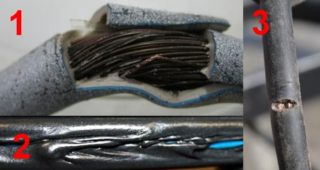
With the hidden organization of the wiring, there are risks of damage to the insulated cable cores. They occur in such cases:
- Exceeding the standard service life. An apartment in a building built in the 50-90s of the twentieth century is equipped with aluminum or copper wiring. According to VSN 58-88, copper conductors are replaced once every 30 years, aluminum - once every 30 years.
- Improper use. Overloading the mains leads to heating and destruction of the power cable insulation.
- Mechanical damage to current conductors. They occur when the installation technology is violated or the walls were drilled incorrectly.
Insulation has a constant resistance value but should be checked if leakage is suspected.
What is the danger of a leak

If the insulating layer loses resistance, a person, touching the body of household appliances, wire sheath, plug-type plug, socket, water supply or heating pipe, walls of a residential building, will act as a conductor. Through his body, the leakage current will flow into the ground. In this case, there are risks of partial injury or death.
Leakage current will affect the quality of power consumption. Some consumers may not work in the house, but even when the equipment is off, the electricity consumption will be reflected on the electric meter.
Grounding electrical appliances will prevent electric shocks from touching the chassis. In this case, the fixing point of the conductive cable will begin to generate heat intensively, which will cause the wiring to catch fire.
Characteristic signs
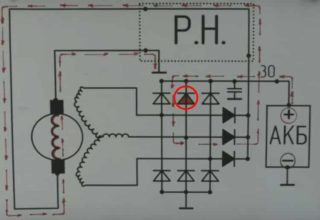
You can find out the current leakage by the following signs:
- slight tingling sensation when touching the wall, pipes, household appliances;
- increased power consumption for no apparent reason;
- starts knocking out plugs when several devices are turned on;
- interference and noise from a working radio;
- electrical appliances do not work when connected to the network;
- electric shocks in the bathroom during water procedures.
To eliminate the phenomenon, you need to identify its cause.
How to check and find the leakage current with your own hands
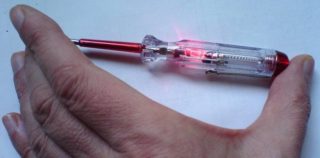
At home, you can apply a simple method - checking the leakage with measuring instruments.
Indicator screwdriver
The instrument can be used to find the phase on the objects-conductors. Use the tip of the screwdriver to touch different areas. If the light bulb comes on, the insulation layer is broken.
Working with a multimeter
The device is used in ohmmeter mode to clarify resistance indicators. You will need to turn on the multimeter, transfer it to an ohmmeter, look at the indicators between the equipment cases and each of the pins with the probes. Leakage is indicated by a value greater than 20 mΩ.
An indicator less than 5 mA is not dangerous if electrical appliances are reliably grounded.
Continuity with a megohmmeter
Household appliances will need to be disconnected from the network. Since the device is able to find damage on voltage insensitive equipment, you will need to touch it with the test leads. By rotating the handle, voltage is generated. Leakage is detected if the resistance is more than 20 mΩ.
With a sharp jump in voltage from 500 to 1000 V, the low-current electronics fail.
How to determine if an electrical appliance is damaged
Devices with a metal housing become life-threatening if they are exposed to phase voltage. You can determine the leak like this:
- Touch an unpainted metal part with a neon screwdriver. A weak glow from the bulb indicates a leak. The check is carried out on two polarities of the connection.
- Turn off the equipment by removing the plug from the network. Bring the switch in the room into operation. With one probe of the multimeter, touch the device, with the other - to the outlet. Measurements are made in both polarities.
Do not touch household appliances with your hands.
Finding problems in the wiring
A damaged circuit of hidden wiring often becomes the cause of electric shock during repair and finishing work. The leak can be easily checked with a transistor radio.
The device is tuned to pick up medium and long waves, listening to the station in silence. The radio is turned on at full volume and the search is started by swiping it practically along the wall. Speaker noises and background noise indicate damaged communications.
Means of protection
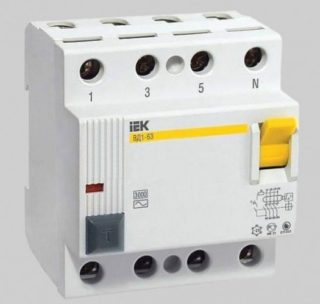
To protect yourself from electric shock, and household appliances from breakdowns, the following protection methods are used:
- grounding of all household appliances and devices;
- installation of ShDUP (additional equipotential bonding bus) in the bathroom;
- installation of an RCD that reacts to total readings of about 100 mA and quickly turns off the devices;
- installation of a difavtomat that cuts off electricity only in damaged areas;
- replacing the jumper blocks in the shield and connecting them with high-quality terminals;
- laying of a new electrical line with high-quality insulation.
The organization of protection requires compliance with safety standards and professional skills, so you will need the help of specialists.
Detection of current leakage will protect a person from injury or death, prevent equipment breakdown. Independent changes should be carried out in compliance with safety regulations, and the line of defense should be organized with the involvement of qualified electricians.









“The device is used in the ohmmeter mode to refine the resistance values. You will need to turn on the multimeter, transfer it to an ohmmeter, look at the indicators between the equipment cases and each of the pins with the probes. Leakage is indicated by a value greater than 20 mΩ. " Forgot to warn you! This can only be done when the power is off, otherwise the multimeter will fail if it is not equipped with protection. This will happen because if there is a leak at the measured points, there will necessarily be a potential difference.
“Turn off the equipment by removing the plug from the network. Bring the switch in the room into operation. With one probe of the multimeter, touch the device, with the other - to the outlet. Measurements are made in both polarities. " This is the first time I hear that there is polarity when measuring AC voltage! And then, measurements between the phase wire and the device case are not informative, they only indicate that there is a phase in the outlet and the device case is grounded. Therefore, it is necessary to measure between the "zero" wire and the body of the device.